Oscar英文介绍ppt
- 格式:ppt
- 大小:1.93 MB
- 文档页数:22


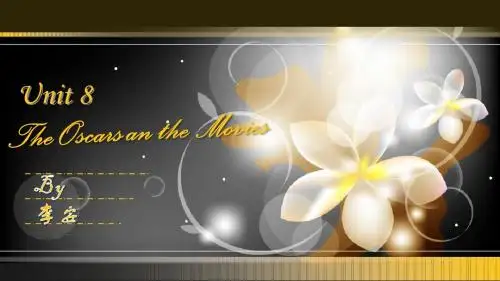
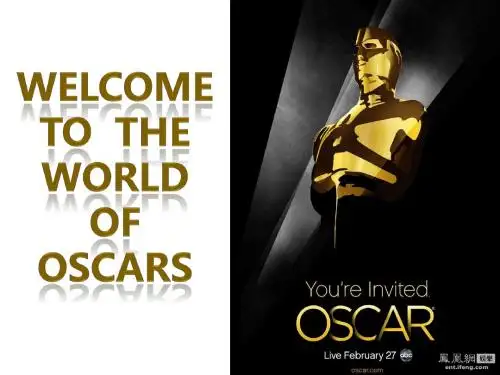
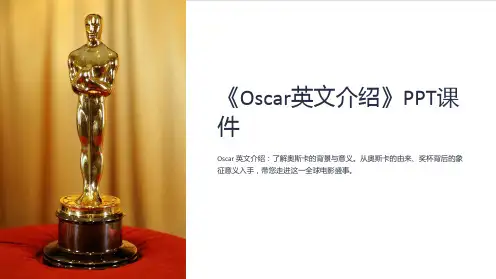



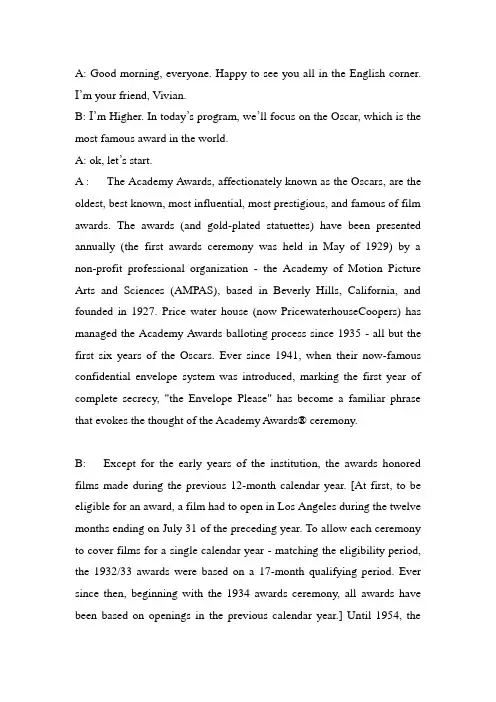
A: Good morning, everyone. Happy to see you all in the English corner. I’m your friend, Vivian.B: I’m Higher. In today’s program, we’ll focus on the Oscar, which is the most famous award in the world.A: ok, let’s start.A : The Academy Awards, affectionately known as the Oscars, are the oldest, best known, most influential, most prestigious, and famous of film awards. The awards (and gold-plated statuettes) have been presented annually (the first awards ceremony was held in May of 1929) by a non-profit professional organization - the Academy of Motion Picture Arts and Sciences (AMPAS), based in Beverly Hills, California, and founded in 1927. Price water house (now PricewaterhouseCoopers) has managed the Academy Awards balloting process since 1935 - all but the first six years of the Oscars. Ever since 1941, when their now-famous confidential envelope system was introduced, marking the first year of complete secrecy, "the Envelope Please" has become a familiar phrase that evokes the thought of the Academy Awards® ceremony.B: Except for the early years of the institution, the awards honored films made during the previous 12-month calendar year. [At first, to be eligible for an award, a film had to open in Los Angeles during the twelve months ending on July 31 of the preceding year. To allow each ceremony to cover films for a single calendar year - matching the eligibility period, the 1932/33 awards were based on a 17-month qualifying period. Ever since then, beginning with the 1934 awards ceremony, all awards have been based on openings in the previous calendar year.] Until 1954, theOscars were presented mostly on a Thursday evening. From 1955 to 1958, they were presented on a Wednesday. From 1959 until 1998 the Oscars were, with a few exceptions, presented on a Monday night. Only since 1999 has the Awards ceremony taken place on a Sunday (traditionally in March). In 2004, the ceremony was moved even earlier to improve ratings and to be more relevant to the awards 'season'.A: Comments About the Awards Themselves:The establishment of the Academy (and its awards system) has had a major effect and influence upon the film industry, due to the enormous boost a nomination or award (for a film or actor) creates, by giving prestige and bottom-line profits to a studio or performer. Studios have often engaged in expensive marketing and advertising campaigns to sway votes, and to encourage contractual loyalty during voting. The Academy has, with limited success, tried to limit the influences of pressure groups and promotion, box office gross receipts, and studio public relations and marketing on voting results. It has also attempted to limit votes for melodramatic sentimentality, atonement for past mistakes, personal popularity, and "prestige" or epic scale, but those influences have often had a decided effect upon the outcome of some of the poll results.B: Unfortunately, the critical worth, artistic vision, cultural influence, and innovative qualities of many films are not given the same voting weight. Especially since the 80s, moneymaking 'formula-made' blockbusters with glossy production values have often been crowd-pleasing titans (and Best Picture winners), but they haven'tnecessarily been great films with depth or critical acclaim by any measure. See The Worst Academy Awards Oscars for more.A: Like any other awards, recognitions, or "best" lists, the top nominees and winners do not necessarily reflect or objectively measure the greatest that cinematic history has to offer. Many of the most Deserving Films of All Time (see Films Without Awards) did not win Academy Awards (and in some cases were not even included in the nominees). In addition, Top Box-Office Films aren't always guaranteed awards success either. And certain Film Genres (notably westerns, science fiction, and comedy) as well as independent films are not represented in balanced numbers throughout Oscar history.B: OK, so much for today. See you next week.A: See you.。
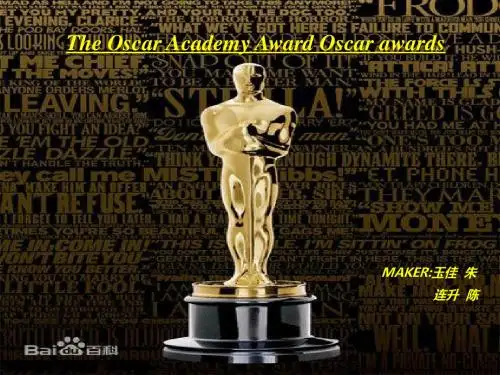
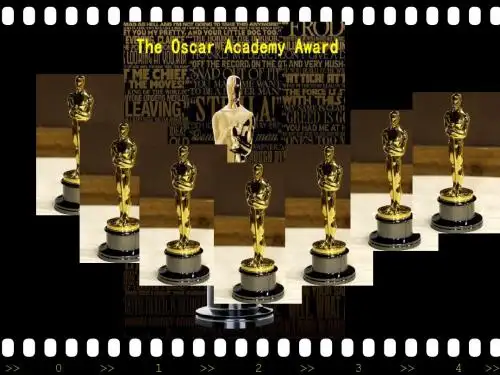
The History of the OscarsThe Academy Awards, popularly known as the Oscars, are a set of awards for artistic and technical merit in the film industry. They are given annually by the Academy of Motion Picture Arts and Sciences (AMPAS) to recognize excellence in cinematic achievements as assessed by the Academy's voting membership. The awards, first presented in 1929 at the Hollywood Roosevelt Hotel, are overseen by the Academy of Motion Picture Arts and Sciences.Origins and Early YearsThe Oscars were first held on May 16, 1929, at a private dinner hosted by Douglas Fairbanks at the Hollywood Roosevelt Hotel. The ceremony honored the best films of 1927 and 1928. The initial award winners were announced three months before the ceremony, but that changed in subsequent years as the winners began to be kept secret until the actual event.The StatuetteThe iconic Oscar statuette, officially named the Academy Award of Merit, was designed by sculptor George Stanley. The statuette depicts a knight rendered in Art Deco style holding a crusader's sword standing on a reel of film with five spokes, symbolizing the original branches of the Academy: actors, writers, directors, producers, and technicians. Since 1930, the statuettes have been made of gold-plated bronze, though during World War II, they were made of painted plaster due to metal shortages.Growth and PopularityThroughout the years, the Oscars have grown in both size and scope. The first televised Oscars took place in 1953, which allowed the global audience to witness Hollywood's biggest night. Theceremony has since become a major event in the entertainment industry, watched by millions of people worldwide.Milestones and ChangesOver the decades, the Oscars have seen many significant changes and milestones:- 1940: Hattie McDaniel became the first African American to win an Oscar for her role in *Gone with the Wind*.- 1968: *In the Heat of the Night* won the Best Picture award during a time of significant social change in the United States.- 2002: Halle Berry became the first African American woman to win the Best Actress award for *Monster's Ball*.- 2009: *The Hurt Locker*, directed by Kathryn Bigelow, won Best Picture, making Bigelow the first woman to win the Best Director award.Modern EraThe Oscars have continued to evolve, incorporating new categories and adjusting criteria to better reflect the diverse nature of contemporary cinema. Recent years have seen a push for more diversity and inclusion within the nominations and awards process. The Best Picture category was expanded from five nominees to a maximum of ten in 2009 to allow a greater variety of films to be considered.Controversies and CriticismsDespite its prestige, the Oscars have not been without controversy. Criticisms have included a lack of diversity in nominations, perceived snubs, and questions about the relevance of the awards in modern filmmaking. These issues have led to reforms within the Academy and ongoing discussions about how to make the awards more inclusive and representative of the global film community. ConclusionThe Oscars remain a symbol of excellence in the film industry, celebrating the art and craft of filmmaking. While the ceremony and the Academy continue to adapt to the changing landscape of cinema, the core mission of honoring outstanding achievements in film remains unchanged. The Oscars not only reflect the past and present of the film industry but also influence its future, inspiring filmmakers and audiences around the world.---Word Document Formatting Steps:1. Open Microsoft Word.2. Select "Home" from the top menu.3. Set the font to "Times New Roman" and the font size to "12".4. Center-align the title "The History of the Oscars" and set the font size to "16" in bold.5. Insert appropriate headings for each section (e.g., "Origins and Early Years", "The Statuette", etc.) and set them to "14" in bold.6. Justify-align the main text for a clean, professional appearance.7. Use 1.5 line spacing for better readability.8. Ensure there is a space between each section.9. Save the document as "The History of the Oscars.docx".This way, you will have a well-organized and properly formatted document on the history of the Oscars.。